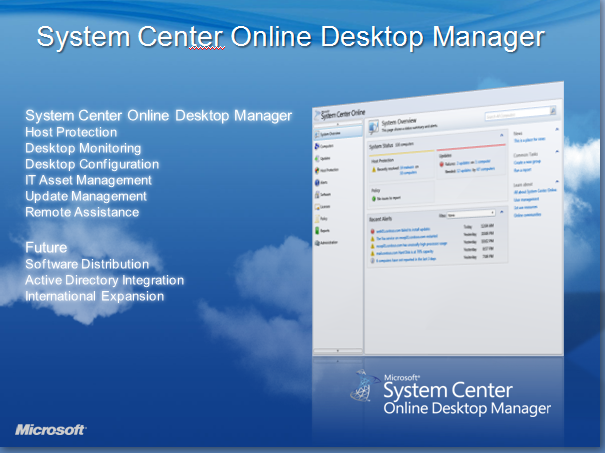Microsoft launches beta of cloud-based Windows management service

Microsoft is pulling back the covers today on another offering in its Microsoft-hosted cloud-computing family: Windows Intune.
Windows Intune has been years in the making. Last spring, Microsoft officials announced with much fanfare Redmond's plans to deliver systems management in the cloud, via a service known as System Center Online Desktop Manager (SCODM). SCODM, codenamed "Jupiter," went to a set of select testers, but then seemingly disappeared.
On April 19, Microsoft is relaunching SCODM -- to which the company has added some new licensing and Windows deliverables -- as Windows Intune. It will be available to the first 1,000 customers and partners in the U.S., Canada, Mexico and Puerto Rico who sign up for it between now and May 16.
Based on SCODM tester feedback, Microsoft repositioned and rejiggered the Windows Intune service to appeal primarily to mid-size customers (those with between 25 and 500 PCs) who don't want to sign up for the company's Software Assurance annuity-licensing plan, said Sandrine Skinner, a Director in the Windows Commercial Product Management unit.
The goal of Windows Intune (now codenamed "Florida," for those keeping score at home) is to provide IT professionals with a way to manage and secure PCs from anywhere. There are two components to Windows Intune: On-premises Windows and Windows management tools, plus an online management and security service.
Windows Intune customers get the rights to Windows 7 Enterprise Edition -- currently available only to Software Assurance licensees -- as well as Microsoft Desktop Optimization Pack (MDOP), the set of desktop deployment and management tools also only available to Software Assurance customers today.
"You get everything an Enterprise Agreement customer would get with Software Assurance benefits, but you don't need Software Assurance," said Skinner.
On the cloud side, Windows Intune, not surprisingly, sounds a lot like SCODM. It includes a Web-based administration console; desktop monitoring and configuration; update management; remote assistance; and asset management.
(Here's a slide showing what Microsoft was planning/promising with SCODM, for comparison.)
The Windows Intune service builds on top of the Microsoft Malware Protection Engine (the same anti-malware/anti-virus engine at the heart of Microsoft's free Microsoft Security Essentials service for consumers and the Forefront suite for business customers). It allows IT pros to set security policies for users' machines, even those outside the corporate network, by installing a piece of client-based software on Windows XP, Vista and/or Windows 7 PCs.
Microsoft is planning to deliver the final version of Windows Intune within a year from now, Skinner said. Additional pricing/licensing details are not available at this time, she said.
From this early information, what do you think of Microsoft's Windows Intune plan? Did Microsoft's decision to add Windows 7 Enterprise and MDOP functionality to the package -- along with eliminating the Software Assurance requirement -- make it any more interesting/useful to you and your organization?
